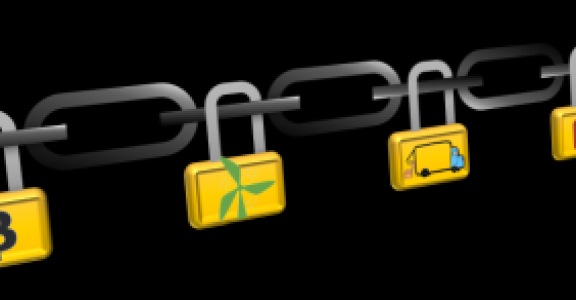The 1970s brought us the mainframe, the 1980s the PC, the 1990s the Internet, the Millennium the social/mobile Web - albeit a potentially arguable evolution - and the 2010s introduced us to the bitcoin and the blockchain. What exactly is the blockchain? And how come, despite its enormous potential, its industrial adoption (in Belgium) is lagging behind?
The concept of the blockchain lies in its technical structure - a chain of blocks linked together via a cryptographic hash. Each block represents a data structure, which records a list of transactions created and exchanged by blockchain network peers. As such, transactions can exchange monetary sums (i.e. cryptocurrencies such as the bitcoin) or any other information (i.e. sensor readings, certificates, product data) to be shared between multiple peers. Additionally, it also allows the execution of an arbitrary code within so-called smart contracts (e.g. triggering payment when electricity is delivered, buying automatically when an agreed price is reached).
A blockchain is a distributed digital ledger, which is decentralised between multiple readers, writers, observers and, as such, is secure by design. In other words, security is supported precisely thanks to its distributed trust mechanism. As transactions are recorded across many peers, the record cannot be altered without altering all subsequent blocks (bearing in mind that everybody is watching). This allows peers to verify and audit transactions by a so-called distributed consensus since all peers can view the blockchain status (see Byzantine Generals).
As such, the use of a blockchain is recommended in situations where multiple mutually mistrusting entities want to interact and are not willing to agree on an online centralised trusted third party.
Advantages
Its advantages are numerous: security (by design), decentralisation (no need for a trusted third party), public verifiability of interaction accuracy, process transparency, information integrity, data redundancy. Its limited privacy due to transparency is a minor issue, which can be enhanced through cryptographic techniques.
A blockchain is not restricted to the financial world, but offers a large and diversified set of applications such as logistics (tracking of goods), smart contracts (energy, licenses), supply chain management (product origin), human resources (certifications), distributed cloud storage, smart property, IoT, healthcare, ownership and royalty distribution, decentralised autonomous organisations, proof-of-ownership, e-voting (immutable).
In a nutshell, thanks to its characteristics and various application domains, the blockchain is a technological innovation that allows new interaction models. Literally, the most promising solution for revolutionising the Internet. As such, it can be seen as a new and additional layer, where every keystroke is a transaction, every correspondence, Facebook like, event registration, etc.
So how come, despite its enormous potential, its industrial adoption (in Belgium) is lagging behind?
What points are no real obstacles?
The technology. Although some acknowledged drawbacks remain, such as technical, security, privacy and usability (interface between the physical and the digital) issues, a large number of tools and out-of-the-box solutions exist at varying maturity levels. Examples are Bitcoin, Ethereum, Zerocash, Hyperledger, Corda, EOS.
The expertise. As a new hype with promising growth potential, there is definitely no lack of expertise in the blockchain field. Although, the true potential of the technology is still very much in its infancy, we can note a growing number of research groups, publications, workshops, encounters, innovation centres, blogs (current company included), conferences, online courses, keynotes, … Everybody is an expert.
What points do we see as genuine obstacles for its adoption?
The potential offered by the blockchain's distributed trust mechanism is huge, for it can be used as a reliable trust system in many applications.
By design, blockchain is not just a novel disruptive technology. Interestingly, it also fundamentally influences a company’s overall product management, organisation and business. Thus, the adoption of a blockchain requires a complete mind switch with regard to resource planning, team expertise, partnership networks, to name a few.
Product management. The idea of a distributed ledger between multiple entities influences the way product data is handled. Registering these data on the blockchain may result in privacy concerns (production volume, type, times) due to its transparency towards your partnership network. This is tackled by the introduction of permissioned blockchains where a centralisation mechanism is responsible for assigning specific roles to cooperating entities. However, switching from “permissionless” to permissioned blockchain is somewhat in contradiction with the original public distributed trust mechanism and results in reduced transparency.
In addition, in the case of IoT, although sensor data are definitely transparent and verifiable by multiple entities, they are not necessarily correct. Automatic transactions relying on such data are thus at risk.
A challenge exists in the in-depth exploration of how product data is shared on the blockchain, to provide the best balance between privacy and transparency.Organisation. Switching from a centralised product management to a decentralised approach involving various entities with different roles and stakes can scare the best of us. Deploying a blockchain in a partnership network requires more coordination from the organisation, since the processes that need to be replaced may be wide-ranging, deeply embedded within the institution and highly heterogeneous in nature.
Due to its nature, the blockchain is a perfect business tool for keeping records of transactions (past action, performance, future planning), which provide a view of the company's internal operation and external relationships. However, every organisation keeps its own private records, which are mostly distributed across internal departments and functions.
Therefore, the reconciliation of transactions across individual and private ledgers into a public decentralised network is expected to drain resources and be prone to errors.Business. Blockchain foreshadows the need to break company boundaries and to adopt an open model for interacting with partners. It involves coordinating the activity of many actors and gaining institutional agreement on standards and processes. Its adoption requires major social, legal, and political change in addition to its technological hurdles. In the example of smart contracts, one could argue how binding these really are.
In addition, as companies are built on contracts, how does automating them into a blockchain affect traditional business structures, processes, and stakeholders (lawyers, accountants, managers)?
Blockchain therefore requires a radical change in internal roles as well as exploring novel ways of executing one’s business.
In conclusion, this is where Sirris makes the difference. Our key value is our in-depth research on the technology in its actual company context: overall product processes, business organisation and strategic roadmap. This includes the identification of whether the business actually needs a blockchain, what its key added value is and how to integrate it seamlessly and painlessly in the industrial landscape.
So let’s hope we can give you 2020!

